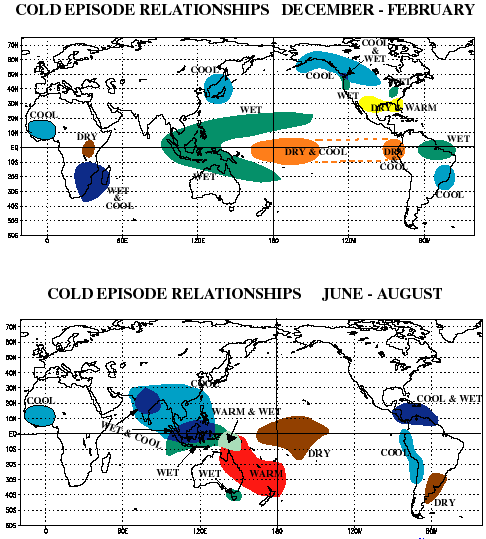The most frequently asked question to me during the past few weeks is about what to expect this winter. 2009-10 was extremely cold and in some parts of the deep south the coldest on record. Among the biggest concerns of questioners has been related to whether that level of cold will repeat this year.
Often the focus each winter is the state of the
El Nino/La Nina Southern Oscillation (ENSO). Many of you know my annoyance at mainstream forecasts which display a map like the one below and walk away believing that the public has been served. Ladies and Gentlemen, it is often stated "
The Devil is in the details".
Here is a detail, which if it becomes true will make a huge difference between a stereotypical mild and dry winter for Central NC and VA and something much different. When La Nina's effects on global circulation reach a bottom in mid or late season then the "boring" winter usually wins. What happens if the bottom is reached during the preceding autumn? Did this La Nina episode just do that?

Source: Earth Science Research Laboratory |
In addition to a probable early bottom of La Nina we must also factor in the ongoing extended period of low solar activity. While sunspots and solar flux have risen above the doldrums of the long minima between cycles 23-24 it has not risen much at all. Based on historical evidence of low solar activity
correlating very well with extreme weather and cold winters there is concern that if the sun does not return to higher levels of activity that
another Ice Age could develop.
Extreme winter events in the Southern Hemisphere is a cause of concern. There was the massive cold wave which swept South America. The cold devastated fish populations, livestock, and killed people. Snow and sleet was observed in tropical regions and the cold
actually crossed the equator ! Recently spring blizzards raged in New Zealand for six days. Over
350,000 lambs were estimated to have been killed by the weather.
Another variable is the ongoing but lower level volcano activity in the high latitudes. Such activity will certainly reinforce the propensity for blocking patterns which has caused global grief this year in the form of prolonged extreme weather. If the
Katla volcano blows its lid in Iceland then the risk of dangerous winter cold engulfing much the the US and Western Europe would rise significantly.
How do I see Winter 2010-11 based on an Autumn bottom of La Nina?
- Overall average temperature a little colder than neutral BUT getting there by wild swings in temperatures.
- Last year's cold was persistent and costly. 2010-11 should include shorter periods of extreme cold. It would not surprise me if Central VA and NC experience periods of unbelievable cold with lows below 15.
- There will be breaks in the winter action. Keep some short-sleeved shirts handy. Perhaps even some time to get a January tan! (70's) . But unlike last winter we will get some real warm spells.
- Not as much persistent snow in VA. BUT... If one wants to roll the dice for blockbuster winter events then this is a good year to do it. IF the weakening La Nina thesis works then there will be at least one period where arctic cold and the southern jet stream can produce a memorable or historic period of weather. 1995-1996 and 1999-2000 had seasons which appear similar to this one. I am not sure how 1935-36 might correlate. 35-36 was a snow blockbuster for our region and featured a persistent negative NAO. That being said ... snow in the Raleigh area is episodic, therefore cannot be predicted using statistical averages. Our propensity for sleet and freezing rain can conceal bad winters because we do not count all frozen precipitation.
Therefore I believe that exciting but challenging weather lies ahead. If it is discovered that the La Nina circulation deepens further instead of weakening as winter commences then the final forecast will be kinder and gentler.

















